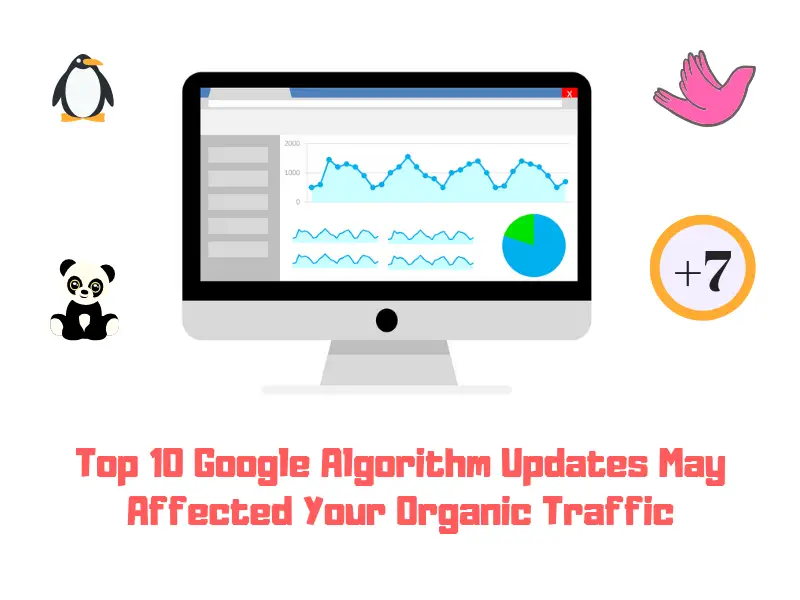Top 10 Google Algorithm Updates that can Affect Your Organic Traffic
Top 10 Google Algorithm Updates that can Affect Your Organic Traffic

A prominent online presence has become the need of the hour. With almost everyone switching online, just getting your website optimized is not enough. To become successful, you need to keep yourself updated with every change introduced by major search engines, especially Google.
The responsibility to stay updated becomes more if you are an SEO professional. Whether you are an expert in the field or just a novice in the field of digital marketing, it is essential for you to be familiar with the Google algorithm updates. In case, you have missed out the updates, you can browse through the top 10 Google algorithm updates listed below.
1. Google Panda Update
Duplicate content and low-quality content removal have been the prime focus of Panda since it was introduced in the year 2011. Though it came into existence in 2011, it took five years to incorporate Panda as an SEO update. It was in 2016, that Google declared it an important algorithm update.
With each update, Panda becomes stricter on the thin and low-quality content appearing in the search results, while it rewards unique or compelling content available online.
If you are new to the digital marketing field, you may like to know that Panda updates do not just affect any particular section of your page or an individual page, it actually enters the total site and reduces the ranking of low-quality pages significantly.
To ensure a positive Panda result, you need to strictly avoid duplicate pages and get rid of the ones with no title. Also, you need to use a specific keyword for every page and ensure there is no keyword stuffing. Spun content, rewritten articles or plagiarized pages are also a strict no for Panda. To improve your SERP, get unique and logical content.
2. Google Penguin Update
The webspam algorithm update, which was launched by Google in the year 2012, later came to be known as the Google Penguin update. As the name says, this update specifically targets the spam links as well as manipulation of the link building process.
While Panda waged the war on low-quality content, Penguin made it easier for the search engine to target the pages that do not serve any purpose of the visitors. The introduction of Penguin restricted the use of Black Hat SEO techniques for manipulating rankings using spam links.
Penguin, which looks only at the incoming link to the sites, ensures that the links are relevant, authoritative and natural. This, in turn, reduces low-quality content from the search engine results.
To improve your SERP in the presence of Penguin, you need to ensure a completely bad backlinks free website. Also, you need to replace the previous bad backlinks with new and effective backlinks. Some sites have failed to recover their ranking only because they did not make the effort of removing each and every bad backlink.
3. Google Hummingbird Update
Hummingbird update is said to be complete overhauling of the core algorithm of Google. Made official on September 2013, Hummingbird was designed to decipher the intent of every search query made on Google and getting them matched with the most relevant results.
To make a positive impact with Hummingbird, it is essential for you to understand the knowledge graph and semantic search, which heavily impacts the search engine features of Google. When updating your page or adding a new page, ensure it is in sync with the keyword used for searching the page as Google has its knowledge graph for offering the most suitable result.
To ensure complete functionality of Hummingbird, the SEO giant Google already initiated its knowledge graph based on a host of SERP features. The SERP features were designed for offering faster and accurate answers to any queries of the users regarding the things or places, they search on the web. When researching about SERP, you need to know that the results do not just contain standard organic results and links to different websites, it also has a significant amount of knowledge graph data for the ease of understanding.
4. Google Pigeon Update
Released on August 2013, Pigeon update tied the local search algorithm of Google with the web algorithm of the search engine. It gave a major jolt to the local search algorithm of the search engine by improving the rankings based on the location and distance of the user.
With Pigeon, Google aimed at offering a stronger web presence to the local businesses based on their location. It has helped the search engine to track down distance successfully and now it shows three most relevant businesses on the SERP. There is a significant change in google search results and google maps results because of the pigeon update.
Even though Pigeon update has helped in modifying the local search results to some significant extent, it garnered a mixed response from the webmasters on the day of its introduction, as some of the websites got de-ranked significantly while other in sync with Pigeon update improved its position.
The algorithm helps People who are offering products or service to nearby location gives more accurate results instead of a far location. The results were narrowed to a particular specific location where business can potentially focus more on their services.
Therefore web algorithm and pigeon update are now connected to make strong local presence along with ranking factors more deeply. This will also help decrease in spam listing and run the business successfully.
5. Mobile-Friendly Update
Launched in April 2015, the mobile-friendly update of Google, which is more popularly known as Mobilegeddon targeted to make the websites more mobile-friendly. Noticing the increased number of mobile web users, Google decided to introduce this update so that the sites can be easily accessed from all devices. The three major pointers that Google gave while introducing this update are:
- The rankings will only be used for mobile devices
- Rankings will be provided to an individual page and not the website
- The results will affect every language across the globe
It is this update of Google that gave users the ease of accessing every page conveniently from any portable device. With the introduction of this update, every website could transfer to the mobile-friendly page by using the Search Console and did not face much problem in the process.
Migration of the websites eased the surfing process of the smartphone users and the mobile version of every page will remain preserved in the cache page of the search engine. Thus, it can be referred at any time needed. Google also provided a complete set of developer documentation for the ease of understanding and execution.
6. Google RankBrain
RankBrain is a core algorithm component of Google, which uses machine learning for determining the most relevant results of any query placed on the search engine. Before this update, Google relied on the basic algorithm for determining the results of any query.
Now, with RankBrain, the query has to pass through an interpretation model, which includes factors like searchers location, personalization and query words for determining the actual intent.
With RankBrain, Google now has different signals for different queries. It has completely eradicated the concept of one keyword one page and the signal is sent to apply to the entire reputation of the site.
Since it has relied on core algorithm update, it helps to sort billions of web-pages every day and rank most relevant results on the search of a keyword.
7. Possum Update
Released on September 1, 2016, Possum is one of the most significant updates of Google. Though documented, it has remained as an unconfirmed update of the site and targets the local finder as well as the local pack result of Google.
The unavailability of local confirmation by Google has made the task a bit tricky for the professionals as they have no choice but to hypothesize the purpose of the update and its concrete effects. Some of the major impacts of this update as hypothesized by the professionals are:
- Offering filtered results depending on the affiliation
- Improved rankings for businesses located beyond the city periphery
- A better understanding of searcher proximity
Though there is no official confirmation, some sites have experienced a negative impact of Possum update and lost their rankings. To recover the rankings, sites need to incorporate themselves in an appropriate business category and also get improve their local search results.
8. Google Fred update
Introduced in March 2017, Google Fred made a significant impact on the rankings of millions of websites. This update actually wreaked havoc on the sites using aggressive ad monetization and Black Hat SEO techniques to improve their rankings. The techniques may be unwanted ads with over monetization, low content and other black hat techniques to improve organic traffic.
As the update was meant for making search engines more user-friendly, it de-ranked the sites, which just wanted to make money by adding advertisements to their page instead of focusing on the problem solving of users.
The update was to clean up spam sites with thin content, aggressive ads and provides quality information which solves the problem of the user. The best practice is to follow google guidelines with a better piece of information.
People who implemented too many ads without focusing on content have to lead significantly drop in traffic and rankings. To recover from google fred update just focus on high-value content with limited ad monetization.
9. Mobile-First Index Roll-out
Mobile-first index roll-out as the name suggests is about making the site friendlier for the mobile phone users. Mobile-first indexing means Google will crawl, index and rank the mobile version of the page so that mobile users can get easy access to the information that they are looking for.
This concept has gained momentum in the past few years and is expected to become more prominent in the coming days as the inclination toward mobile surfing is on the rise.
10. Deindexing Bug
On April 5th, many websites started to drop in ranking and also de-indexed from the google search engine. So Google confirmed there was a bug which was causing trouble to the pages and getting de-indexed. This may be happened due to algorithm updates or any technical issues which lead to indexing problem.
Google provides webmaster tools to check and analyze the pages indexed or not. If not indexed you can ask to crawl and index the pages. But checking millions of pages manually is impossible to track and index the pages. It has happened to many website owners overnight and caused a loss in organic traffic.
The de-indexing bug has given several sleepless nights to the digital marketing professionals as they saw the sites getting de-indexed all of a sudden. Though Google announced that the sites will get indexed automatically and there is no reason to be worried, it is always safe to keep a manual check on the websites and get it indexed, whenever needed.




